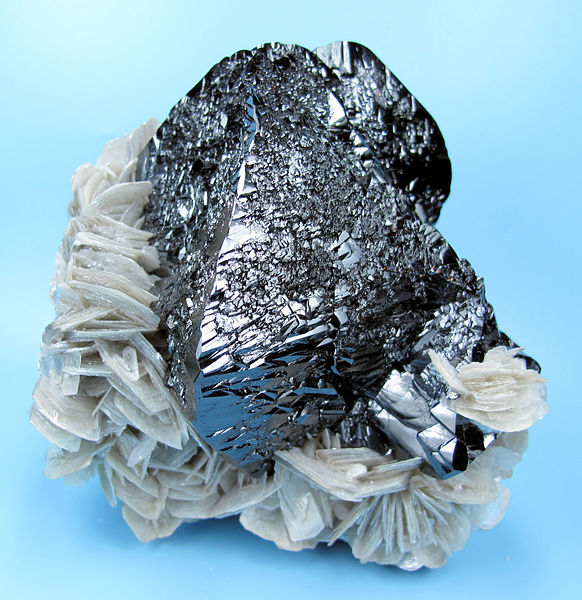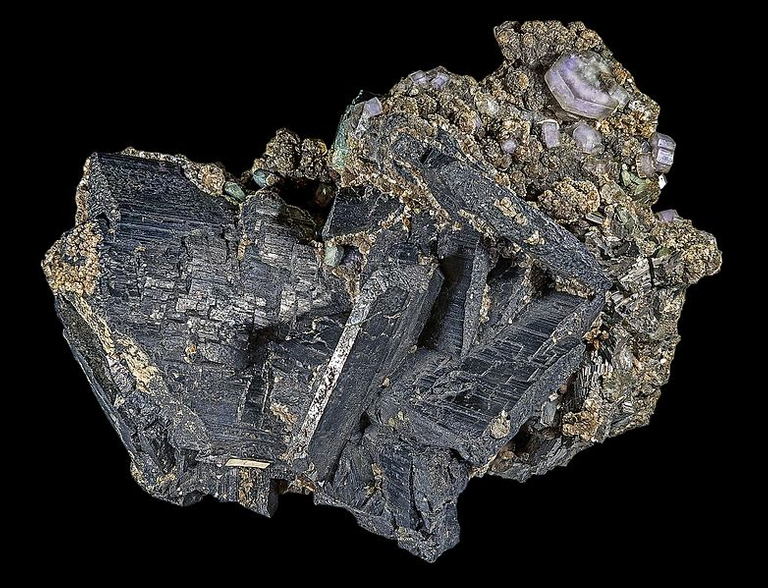Part 1, Part 2, Part 3, Part 4, Part 5
Traditionally, the understanding of the relationship between resources and conflict is an acquisitive one. Wars are fought over resources. Athens fought its wars of conquest to get more timber once it had run out. Rome kept expanding because it consumed more than it produced. So on and so forth. Over the past couple of decades, however, that understanding of conflict has been challenged by a very distinct type of resource- the conflinct resources, as best exemplified by the blood diamond.
Cassiterite, the primary ore we obtain tin from, both today and stretching back to antiquity. Cassiterite is one of the primary conflict minerals. The tin from cassiterite is used for everything from tin cans to solder for circuit boards. The cassiterite deposits in the Democratic Republic of the Congo was a major cause of the decades-long conflict there. This particular sample has muscovite crystals growing on it. [Image source]
Conflict minerals are mined in, as the name suggests, conflict zones. They're then sold for the express purpose of supporting the war efforts of one side or another in the conflict. This is pretty clearly a major change from that more traditional understanding of resources and conflict.
There are six primary geological conflict resources- cassiterite, tin, wolframite, coltan, gold, diamonds, and oil. While there are plenty of other in-demand resources, none are so dependent upon conflict areas as these six. The first four are the ones properly referred to as conflict minerals, but all clearly fit in a similar category. All of the above, when present in a region undergoing a serious conflict, have the ability to prolong and worsen said conflict.
Wolframite, the world's primary source of tungsten along with scheelite. While 60% of the world's wolframite deposits are found in China, it's also found heavily in the Democratic Republic of the Congo, where it was a major cause of the conflict there. [Image source]
Many of our most serious conflict mineral examples are found in Africa. The Democratic Republic of the Congo is the site of the most serious conflict mineral related conflict- coltan, wolframite, and cassiterite are all found there and contribute to the decades of brutal conflict. Gold ore, however, is also found there, and is by far the largest contributor to both causing and extending the conflicts. The Democratic Republic of Congo lacks an exclusive claim to conflict minerals, of course- conflict minerals are found across Africa and much of the rest of the developing world. It's a depressingly wide-spread problem. If you include non-mineralogical conflict resources, it expands even farther. Cocaine, for instance, could easily be understood as a conflict resource in many senses.
Thankfully, there are some relatively easier solutions for dealing with the geological conflict resources than some of the others. Take blood diamonds, for example: Forcing companies to have full evidence of their supply chain, for instance, is a strategy that a number of nations, including the United States and European Union, have adopted. Many nations also ban the importation of any diamonds from many states, like Sierra Leone, that supply lots of blood diamonds.They're not foolproof methods, however, and quite a few blood diamonds manage to slip into the supply chain. There's always an official happy to be bribed somewhere. You should never, ever purchase diamonds online- it's one of the primary ways in which blood diamonds sneak into the consumer market. (Really, you shouldn't buy diamonds at all- they're boring, and their value only comes from their artificially enforced scarcity- we literally have several times the liquid supply of diamonds in storage.)
A chunk of coltan, the ore from which niobium and tantalum are extracted. Tantalum is used for capacitors and electric car batteries. (Your videogame consoles quite likely have conflict tantalum in them, fun!) Niobium is used in superconductors. Coltan is, like all the others, involved in the Congo conflict, among others. [Image source]
Conflict minerals fundamentally result from four causes. First, our society's unending obsession with growth. The basic economic theory of modern civilization is one of constant growth. In order to fuel that growth, resource acquisition must always increase. Second, the fact that resources are distributed unevenly around the world. This seems obvious in some senses, but it's an important idea- the resources a country is fated with, essentially by chance, determine much of its future success. Third, we have a depressing tendency to not want to look a gift horse in the mouth, even when said mouth might contain ethnic cleansing or other brutal internecine conflict. Finally, we have the tendency of humans today to export their problems elsewhere. This comes from a lot of places- you don't want a mine in your backyard, labor is cheaper in developing nations, environmental regulations are almost nonexistent in said nations. Japan is often lauded for its excellent forest conservation, for instance- but that comes at the cost of exporting deforestation to tropical third world nations. We'll definitely talk more about that in a later post in this series, but for now, the conclusion you should be drawing from these causes? The developed world bears most of the responsibility for conflict resources in developing nations.
Bibliography:
- https://en.wikipedia.org/wiki/Conflict_resource
- https://en.wikipedia.org/wiki/Blood_diamond
- https://en.wikipedia.org/wiki/Cassiterite
- https://en.wikipedia.org/wiki/Wolframite
- https://en.wikipedia.org/wiki/Coltan
- https://enoughproject.org/reports/comprehensive-approach-conflict-minerals-strategy-paper





Wolframite and coltan? Wow, this was new to me... Free learning for me tonight (thanks to the image captions). After finding what are the chemicals behind them, things got clearer. Thanks :)
I love using image captions as info-dumps, it really helps provide necessary information without disrupting the flow of the article too much. And thanks for reading!
The funny thing is that I mechanically ignored them first. Then I digged the post to find this information which I was sure should be there :p
Back when I did that six part extinction series almost all of the photos were of specific extinct species, and the caption for each outlined how humans drove them extinct.
It may be that the recent interminable "civil" wars in resource rich areas are due to interested powers desiring continued conflict, in order to extract requisite resources at low cost. When warring parties off-load the regions resources in exchange for weapons, they tend to sell their resources at bargain price. The "freedom fighters" in these regions are nothing more than organized crime syndicates raping the region for short-term profit for the benefit of developed worlds. These wars are proxy imperial conquests using local thugs to extract and ship desired resources in exchange for weapons no longer utilized by civilized armies.
Hit the nail right on the head! Note that major world powers tend to be much more effective at quashing these civil wars when the desired resource requires significant infrastructure to extract that would be impossible to establish and maintain under these civil war-ridden states.
Very interesting post. While I have purchased minerals online, none have fallen in the categories you've mentioned. If I had seen some of the specimens looking like the ones you have posted, the temptation may have been greater.
It's always worth checking! And yeah, those are some gorgeous specimens- no wonder they got top billing on their respective wikipedia pages!
The nail has been hit. Such a parasitic relationship between developed and developing countries when it comes to mineral acquisition. Indeed, mineral conflict is a by product of economic growth. Nice one .
Thanks!
Cool post. Humans have been competing for resources forever.
The number of times people say they are against resource extraction, but yet they write on their computers filled with gold and rare earths is amazing. Even that is a conflict. But people do not think about that aspect of technology. You cannot build a server or a house, or a car without mined materials... economics keep things somewhat in check.
Great discussion and article...
PS. Thanks for bringing up this cool topic and important conversation! Keep up the awesome posts!!!
Thanks, will do!
Nicely written, nicely expressed.
It always goes one way, doesn't it? And as the weapons have improved the impact of conflict minerals grows exponentially. I think of the places on earth that are suffering horrible Human crisis and each of them has one or more mineral involved. Directly involved.
Thanks for a great post.
You received a 80.0% upvote since you are a member of geopolis and wrote in the category of "geology".
To read more about us and what we do, click here.
https://steemit.com/geopolis/@geopolis/geopolis-the-community-for-global-sciences-update-4
Your Post Has Been Featured on @Resteemable!
Feature any Steemit post using resteemit.com!
How It Works:
1. Take Any Steemit URL
2. Erase
https://3. Type
reGet Featured Instantly & Featured Posts are voted every 2.4hrs
Join the Curation Team Here | Vote Resteemable for Witness
I find your topic original.. And yeah the resources are uneven in the world but the problem is utilisation and getting profit from these resources are unfortunately on the hand of developed countries. For example in my country we carry almost 90% of boron mineral and it is used in my fields. But as I know, the most using place is vehicle. We can use it instead of fuel oil. But if we start to mine and use it, it will be a war reason..
It is sad how this world runs, and unfortunately I don't how these things are going to change in future considering things have been running like this forever
Thanks for your contribution. It is pretty interesting
What part interested you most?
Congratulations! This post has been chosen as one of the daily Whistle Stops for The STEEM Engine!
You can see your post's place along the track here: The Daily Whistle Stops, Issue #105 (4/15/18)
The STEEM Engine is an initiative dedicated to promoting meaningful engagement across Steemit. Find out more about us and join us today.
Good read, thanks a lot. Wars over resources are always possible due to the wrong vision of the mineral deposits we actually can find on our planet. Just look at the REY-rich mud available near Marcus Island (Japan). This small seabed area can provide 62, 47, 32, and 56 years of annual global demand for Y, Eu, Tb, and Dy, respectively. https://www.nature.com/articles/s41598-018-23948-5